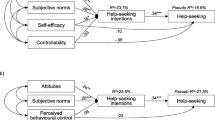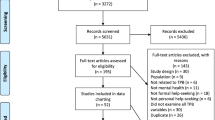Abstract
Purpose
This study tested the efficacy of Ajzen’s theory of planned behavior (TPB) in explaining intention to seek mental health services and compared the traditional TPB model with a TPB partial mediation model. It also aimed to understand factors related to intention to seek mental health services in Macao to inform local policies.
Method
The present study consisted of two phases: (a) a pilot study to develop belief-based measures used in the main study, and (b) a cross-sectional study to investigate the application of TPB in understanding help-seeking intention. In the main study, 337 Macao residents (age range 18–65) participated in a survey conducted in the community.
Results
The TPB partial mediation model was better than the traditional TPB model in explaining help-seeking intention in Macao. The model also suggested that attitude, subjective norm, and perceived behavioral control were all significant predictors of help-seeking intention. However, symptom severity, prior help-seeking, and gender did not significantly directly predict help-seeking intention.
Conclusion
Preference for the TPB partial mediation model may be culturally relevant. The implications of the findings are discussed in relation to the salient beliefs about help-seeking. Limitations and recommendations for future research are provided.


Similar content being viewed by others
Notes
The item descriptive statistics could be found at http://dl.dropbox.com/u/71917286/Descriptive%20statistics.xlsx.
The item intercorrelations could be found at http://dl.dropbox.com/u/71917286/Correlation%20item%20level.xlsx.
References
Frank JD, Frank JB (1991) Persuasion and healing: a comparative study of psychotherapy, 3rd edn. Johns Hopkins University Press, Baltimore
Kessler RC, Chiu WT, Demler O, Walters EE (2005) Prevalence, severity, and comorbidity of 12-month DSM-IV disorders in the national comorbidity survey replication. Arch Gen Psychiatry 62:617–627. doi:10.1001/archpsyc.62.6.617
Wang PS, Lane M, Olfson M, Pincus HA, Wells KB, Kessler RC (2005) Twelve-month use of mental health services in the United States: results from the national comorbidity survey replication. Arch Gen Psychiatry 62:629–640. doi:10.1001/archpsyc.62.6.629
Kessler RC, Berglund PA, Bruce ML et al (2001) The prevalence and correlates of untreated serious mental illness. Health Serv Res 36:987–1007
The WHO World Mental Health Survey Consortium (2004) Prevalence, severity, and unmet need for treatment of mental disorders in the World Health Organization World Mental Health Surveys. JAMA 291:2581–2590
Wang PS, Aguilar-Gaxiola S, Alonso J et al (2007) Use of mental health services for anxiety, mood, and substance disorders in 17 countries in the WHO world mental health surveys. Lancet 370:841–850. doi:10.1016/S0140-6736(07)61414-7
White KS, Raffa SD, Jakle KR et al (2008) Morbidity of DSM-IV axis I disorders in patients with noncardiac chest pain: psychiatric morbidity linked with increased pain and health care utilization. J Consult Clin Psychol 76:422–430. doi:10.1037/0022-006X.76.3.422
Adler DA, Mclaughlin TJ, Rogers WH, Chang H, Lapitsky L, Lerner D (2006) Job performance deficits due to depression. Am J Psychiatry 163:1569–1576. doi:10.1176/appi.ajp.163.9.1569
DSEC (2010) Population estimate of Macao. http://www.dsec.gov.mo/getAttachment/dc166e54-26fa-4baf-83bb-4cc59203bf01/C_POP_FR_2010_Y.aspx. Accessed 25 Jan 2013
Serviços de Saúde (2010) Movimento da consulta Externa. In: Boletim estatístico, pp 39–41. http://www.ssm.gov.mo/statistic/2010/data/link/pdf/2-7.pdf. Accessed 25 Jan 2013
Mo PKH, Mak WWS (2009) Help-seeking for mental health problems among Chinese: the application and extension of the theory of planned behavior. Soc Psychiatry Psychiatr Epidemiol 44:675–684. doi:10.1007/s00127-008-0484-0
Lee S, Lee MTY, Chiu MYL, Kleinman A (2005) Experience of social stigma by people with schizophrenia in Hong Kong. Br J Psychiatry 186:153–157. doi:10.1192/bjp.186.2.153
Philips MR, Pearson V, Li F, Xu M, Yang LH (2002) Stigma and expressed emotion: a study of people with schizophrenia and their family members in China. Br J Psychiatry 181:488–493. doi:10.1192/bjp.181.6.488
Tsang HWH, Tam PKC, Chan F, Cheung WM (2003) Stigmatizing attitudes towards individuals with mental illness in Hong Kong: implications for their recovery. J Community Psychol 31:383–396. doi:10.1002/jcop.10055
Yang LH (2007) Application of mental illness stigma theory to Chinese societies: synthesis and new directions. Singapore Med J 48:977–985
Yang LH, Kleinman A (2008) ‘Face’ and the embodiment of stigma in China: the cases of schizophrenia and AIDS. Soc Sci Med 67:398–408. doi:10.1016/j.socscimed.2008.03.011
Yang LH, Kleinman A, Link BG, Phelan JC, Lee S, Good B (2007) Culture and stigma: adding moral experience to stigma theory. Soc Sci Med 64:1524–1535. doi:10.1016/j.socscimed.2006.11.013
Fischer EH, Turner JL (1970) Orientations to seeking professional help: development and research utility of an attitude scale. J Consult Clin Psychol 35:79–90
Miller MJ, Yang M, Hui K, Choi N, Lim RH (2011) Acculturation, enculturation, and Asian American college students’ mental health and attitudes toward seeking professional psychological help. J Couns Psychol 58:346–357. doi:10.1037/a0023636
Masuda A, Suzumura K, Beauchamp KL, Howells GN, Clay C (2005) United States and Japanese college students’ attitudes toward seeking professional psychological help. Int J Psychol 40:303–313. doi:10.1080/00207590444000339
Nam SK, Chu HJ, Lee MK, Lee JH, Kim N, Lee SM (2010) A meta-analysis of gender differences in attitudes toward seeking professional psychological help. J Am Coll Health 59:110–116. doi:10.1080/07448481.2010.483714
Lee B (2007) Symptom attribution and preferred sources of help for psychiatric symptoms of university students in Singapore. Asian J Couns 14(1–2):49–90
Goh M, Xie B, Wahl KH, Zhong G, Lian F, Romano JL (2007) Chinese students’ attitudes toward seeking professional psychological help. IJAC 29:187–202. doi:10.1007/s10447-007-9038-5
Loya F, Reddy R, Hinshaw SP (2010) Mental illness stigma as a mediator of differences in Caucasian and South Asian college students’ attitudes toward psychological counseling. J Couns Psychol 57:484–490. doi:10.1037/a0021113
Chen SX, Mak WWS (2008) Seeking professional help: etiology beliefs about mental illness across cultures. J Couns Psychol 55:442–450. doi:10.1037/a0012898
Wills TA, Gibbons FX (2009) Commentary: using psychological theory in help-seeking research. Clin Psychol Sci Pract 16:440–444. doi:10.1111/j.1468-2850.2009.01182.x
Becker MH (1974) The health belief model and sick role behavior. Health Educ Monogr 2:409–419
Rosenstock IM (1966) Why people use health services. Milbank Q 44:94–106
Rosenstock IM (1974) Historical origins of the health belief model. Health Educ Monogr 2:328–335
Rosenstock IM, Strecher VJ, Becker MH (1988) Social learning theory and the health belief model. Health Educ Behav 15:175–183
Leventhal H, Nerenz DR, Steele DJ (1984) Illness representations and coping with health threats. In: Baum A, Taylor SE, Singer JE (eds) Handbook of psychology and health, vol IV., Social psychological aspects of healthErlbaum, New Jersey, pp 219–252
Ajzen I (1985) From intentions to actions: a theory of planned behavior. In: Kuhl J, Beckmann J (eds) Action-control: from cognition to behavior. Springer, Heidelberg, pp 11–39
Ajzen I (1991) The theory of planned behavior. Organ Behav Hum Decis Process 50:179–211. doi:10.1016/0749-5978(91)90020-T
Ajzen I, Fishbein M (1980) Understanding attitudes and predicting social behavior. Prentice-Hall, New Jersey
Fishbein M, Ajzen I (1975) Belief, attitude, intention, and behavior: an introduction to theory and research. Addison-Wesley, Massachusetts
Armitage CJ, Conner M (2001) Efficacy of the theory of planned behaviour: a meta-analytic review. Br J Soc Psychol 40:471–499. doi:10.1348/014466601164939
Schomerus G, Matschinger H, Angermeyer MC (2009) Attitudes that determine willingness to seek psychiatric help for depression: a representative population survey applying the theory of planned behaviour. Psychol Med 39:1855–1865. doi:10.1017/S0033291709005832
Skogstad P, Deane FP, Spicer J (2006) Social-cognitive determinants of help-seeking for mental health problems among prison inmates. Crim Behav Ment Health 16:43–59. doi:10.1002/cbm.54
Smith JP, Tran GQ, Thompson RD (2008) Can the theory of planned behavior help explain men’s psychological help-seeking? Evidence for a mediation effect and clinical implications. Psychol Men Masc 9:179–192. doi:10.1037/a0012158
Westerhof GJ, Maessen M, de Bruijn R, Smets B (2008) Intentions to seek (preventive) psychological help among older adults: an application of the theory of planned behaviour. Aging Ment Health 12:317–322. doi:10.1080/1360786080212079741
Bish A, Sutton S, Golombok S (2000) Predicting uptake of a routine cervical smear test: a comparison of the health belief model and the theory of planned behaviour. Psychol Health 15:35–50. doi:10.1080/08870440008400287
Kung WV (2004) Cultural and practical barriers to seeking mental health treatment for Chinese Americans. J Community Psychol 32:27–43. doi:10.1002/jcop.10077
Fishbein M, Ajzen I (2010) Predicting and changing behavior: the reasoned action approach. Psychology Press, New York
Mackenzie CS, Gekoski WL, Knox VJ (2006) Age, gender, and the underutilization of mental health services: the influence of help-seeking attitudes. Aging Ment Health 10:574–582. doi:10.1080/13607860600641200
Ajzen I (2006) Constructing a TPB questionnaire: conceptual and methodological considerations. http://www.people.umass.edu/aizen/pdf/tpb.measurement.pdf. Accessed 25 Jan 2013
Raykov T (2002) Reliability of scales with general structure: point and interval estimation using a structural equation modeling approach. Struct Equ Model 9:195–212. doi:10.1207/S15328007SEM0902_3
Cheng T, Williams P (1986) The design and development of a screening questionnaire (CHQ) for use in community studies of mental disorders in Taiwan. Psychol Med 16:415–422. doi:10.1017/S0033291700009247
Byrne BM (2010) Structural equation modeling with Amos: basic concepts, applications, and programming, 2nd edn. Taylor and Francis Group, New York
Burnham KP, Anderson DR (2004) Multimodel inference: understanding AIC and BIC in model selection. Sociol Method Res 33:261–304. doi:10.1177/0049124104268644
Nunnally JC, Bernstein IH (1994) Psychometric theory, 3rd edn. McGraw-Hill, New York
Angermeyer MC, Matschinger H, Riedel-Heller S (1999) Whom to ask for help in case of a mental disorder? Preferences of the lay public. Soc Psychiatry Psychiatr Epidemiol 34:202–210. doi:10.1007/s001270050134
Thompson A, Hunt C, Issakidis C (2004) Why wait? Reasons for delay and prompts to seek help for mental health problems in an Australian clinical sample. Soc Psychiatry Psychiatr Epidemiol 39:810–817
DSEC (2007) Global results of by-census 2006. http://www.dsec.gov.mo/getAttachment/a56cb8bd-a4ac-4f22-bc0c-55dfc4f02284/C_ICEN_PUB_2006_Y.aspx?lang=zh-MO. Accessed 25 Jan 2013
Chan DN, Wu AS, Hung EW (2010) Invulnerability and the intention to drink and drive: an application of the theory of planned behavior. Accid Anal Prev 42:1549–1555. doi:10.1016/j.aap.2010.03.011
Acknowledgments
We are very grateful to Shu Fai Cheung (University of Macau) and Mark H. C. Lai (Texas A&M University) for their methodological guidance.
Conflict of interest
On behalf of all authors, the corresponding author states that there is no conflict of interest.
Author information
Authors and Affiliations
Corresponding author
Rights and permissions
About this article
Cite this article
Mak, H.W., Davis, J.M. The application of the theory of planned behavior to help-seeking intention in a Chinese society. Soc Psychiatry Psychiatr Epidemiol 49, 1501–1515 (2014). https://doi.org/10.1007/s00127-013-0792-x
Received:
Accepted:
Published:
Issue Date:
DOI: https://doi.org/10.1007/s00127-013-0792-x




